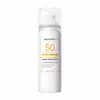What's inside
What's inside
 Key Ingredients
Key Ingredients

 Benefits
Benefits

 Concerns
Concerns

 Ingredients Side-by-side
Ingredients Side-by-side

Water
Skin ConditioningIsopropyl Myristate
EmollientZinc Oxide
Cosmetic ColorantBeeswax
Emulsion StabilisingButyl Methoxydibenzoylmethane
UV AbsorberSorbitan Oleate
EmulsifyingBuddleja Davidii Extract
Skin ConditioningThymus Vulgaris Extract
PerfumingStearic Acid
CleansingEthylhexyl Salicylate
UV AbsorberPolysorbate 20
EmulsifyingSodium Borate
BufferingPolyacrylate-13
Polyisobutene
Phenoxyethanol
PreservativeCaprylyl Glycol
EmollientAloe Barbadensis Leaf Extract
EmollientCitric Acid
BufferingBisabolol
MaskingParfum
MaskingWater, Isopropyl Myristate, Zinc Oxide, Beeswax, Butyl Methoxydibenzoylmethane, Sorbitan Oleate, Buddleja Davidii Extract, Thymus Vulgaris Extract, Stearic Acid, Ethylhexyl Salicylate, Polysorbate 20, Sodium Borate, Polyacrylate-13, Polyisobutene, Phenoxyethanol, Caprylyl Glycol, Aloe Barbadensis Leaf Extract, Citric Acid, Bisabolol, Parfum
Butane
Propane
Isobutane
Isododecane
EmollientWater
Skin ConditioningDisiloxane
Skin ConditioningDimethicone
EmollientEthylhexyl Methoxycinnamate
UV AbsorberEthylhexyl Salicylate
UV AbsorberDiethylamino Hydroxybenzoyl Hexyl Benzoate
UV FilterMenthyl Lactate
MaskingEthylhexyl Triazone
UV AbsorberSilica
AbrasiveMethyl Methacrylate Crosspolymer
Silica Dimethyl Silylate
EmollientMethicone
EmollientHamamelis Virginiana Water
AstringentMethylparaben
PreservativeAroma
Ethylhexylglycerin
Skin ConditioningPropanediol
SolventPiper Methysticum Leaf/Root/Stem Extract
Skin ConditioningCentella Asiatica Extract
CleansingScutellaria Baicalensis Root Extract
AstringentPortulaca Oleracea Extract
Skin ConditioningPhenoxyethanol
PreservativeCeramide EOP
Skin ConditioningCeramide Ns
Skin ConditioningCeramide NP
Skin ConditioningCeramide As
Skin ConditioningCeramide AP
Skin ConditioningBifida Ferment Lysate
Skin ConditioningPentylene Glycol
Skin ConditioningDiethoxydiglycol
Solvent1,2-Hexanediol
Skin ConditioningPvp
Emulsion StabilisingChlorphenesin
AntimicrobialDisodium EDTA
BHT
AntioxidantButane, Propane, Isobutane, Isododecane, Water, Disiloxane, Dimethicone, Ethylhexyl Methoxycinnamate, Ethylhexyl Salicylate, Diethylamino Hydroxybenzoyl Hexyl Benzoate, Menthyl Lactate, Ethylhexyl Triazone, Silica, Methyl Methacrylate Crosspolymer, Silica Dimethyl Silylate, Methicone, Hamamelis Virginiana Water, Methylparaben, Aroma, Ethylhexylglycerin, Propanediol, Piper Methysticum Leaf/Root/Stem Extract, Centella Asiatica Extract, Scutellaria Baicalensis Root Extract, Portulaca Oleracea Extract, Phenoxyethanol, Ceramide EOP, Ceramide Ns, Ceramide NP, Ceramide As, Ceramide AP, Bifida Ferment Lysate, Pentylene Glycol, Diethoxydiglycol, 1,2-Hexanediol, Pvp, Chlorphenesin, Disodium EDTA, BHT
 Reviews
Reviews

Ingredients Explained
These ingredients are found in both products.
Ingredients higher up in an ingredient list are typically present in a larger amount.
Ethylhexyl Salicylate is an organic compound used to block UV rays. It primarily absorbs UVB rays but offers a small amount of UVA protection as well.
Commonly found in sunscreens, Ethylhexyl Salicylate is created from salicylic acid and 2-ethylhexanol. You might know salicylic acid as the effective acne fighter ingredient and BHA.
The ethylhexanol in this ingredient is a fatty alcohol and helps hydrate your skin, similar to oils. It is an emollient, which means it traps moisture into the skin.
According to manufacturers, Ethylhexyl Salicylate absorbs UV wavelength of 295-315 nm, with a peak absorption at 307-310 nm. UVA rays are linked to long term skin damage, such as hyperpigmentation. UVB rays emit more energy and are capable of damaging our DNA. UVB rays cause sunburn.
Learn more about Ethylhexyl SalicylatePhenoxyethanol is a preservative that has germicide, antimicrobial, and aromatic properties. Studies show that phenoxyethanol can prevent microbial growth. By itself, it has a scent that is similar to that of a rose.
It's often used in formulations along with Caprylyl Glycol to preserve the shelf life of products.
Water. It's the most common cosmetic ingredient of all. You'll usually see it at the top of ingredient lists, meaning that it makes up the largest part of the product.
So why is it so popular? Water most often acts as a solvent - this means that it helps dissolve other ingredients into the formulation.
You'll also recognize water as that liquid we all need to stay alive. If you see this, drink a glass of water. Stay hydrated!
Learn more about Water